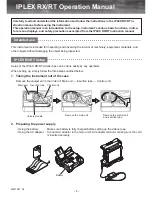
selecting, 8-6
specifying an event, 8-27
start/end conditions, 8-15
total samples, 8-16
using, 8-27
using Auto-range, 8-28
Time Interval Ranges, 8-15
maximum time, 8-16
minimum time, 8-16
range of, 8-5
Time marker value display, 7-89
Time markers, 5-32
Time stamps, 5-31
Time statistics, 8-16
Time tags, 4-10, 5-31, 7-3, 7-33, 7-57
Time Zone field, 7-29
Time-Correlated Displays, 4-10, 7-64
Timer Control Field, 5-12, 5-17 to 5-18
Timers, 9-15
Timing Acquisition Mode, 7-33
Timing analyzer, 4-10, 7-4
and delay, 7-60
sample period, 4-19
vs oscilloscope, 5-26
vs SPA, 8-4
vs state analyzer, 5-28
Top and base voltages, 7-99
Total count
State Overview, 8-5, 8-10
Total samples
State Histogram Mode, 8-13
Time Interval Mode, 8-16
Trace lists
comparing, 3-18
indented line numbers, 5-31
interleaving, 5-29 to 5-30
saving in ASCII format, 6-7
viewing with waveforms, 5-32
Trace modes, 8-8
selecting, 8-8
State Histogram, 8-8
State Overview, 8-8
Time Interval, 8-8
Trace Type
All States vs Qualified States, 8-13
Transitional Timing, 7-33
full channel 125MHz mode, 7-33
half channel 250MHz mode, 7-33
other considerations, 7-41, 9-11
Trig to X default value, 7-88
Trig to X field, 7-88 to 7-89
Trig to X time value resolution, 7-88
Trigger
add sequence level, 4-8
capabilities, 1-6
changing terms, 4-6
cross-arming, 5-22 to 5-29
default triggers, 4-3
Edge trigger, 7-79 to 7-80
events counter, 7-84
Immediate, 3-9, 7-80
marker, 7-79
memory use, 4-16
modes, 3-9
point, 7-79
positioning in memory, 4-18, 5-25
sequence levels, 7-43
setting the trigger point, 7-81
shown in display, 3-14
source, 7-82
store qualification, 4-17
terms, 4-4
trigger level voltage value, 7-81
trigger point range, 7-81
Trigger Position field, 7-56
Trigger sequence, 9-2, 9-12
Trigger term, 9-14
Trigger Menu
count field, 7-57
Trigger Mode field, 7-79 to 7-87
Trigger point, 7-89
location, 7-72
Trigger qualifier, 7-83
Triggering
after lines finish transitioning, 5-14
between analyzers, 7-54
delay-by-events, 7-83
events, 7-83
menus, 5-2
on a handshake violation, 5-20
on a loop that runs too long, 5-12
on a timing violation, 5-23
on asserting chip select lines, 5-15
on bad data, 5-11
on bus contention, 5-21
on control and status signals, 5-24
on entry to a function, 5-10
on intermittent problems, 5-17
on interrupt request, 5-27
on loop iteration, 5-6
on pulse limits, 5-18
on recursive function call, 5-8
on subroutine execution, 5-4
when expected data does not
appear, 5-17
Troubleshooting, 12-11 to 12-22
TTL
levels, 7-10, 7-32
preset values, 7-75
Tx to To field, 7-88
Type: field, 7-31
U
Unsynchronized waveform, 7-81, 7-84
Updating operating system, 7-29
User interface
keyboard, 7-16
User-defined threshold, 7-10
User-level macro, modify, 7-48 to 7-50
Using SPA
in group runs, 8-30
V
Valid runs, 7-59
Vbase, 7-99
Verifying
chip select line is strobed, 5-16
correct execution, 5-4
correct storage, 5-13
efficiency, 5-4
Vertical position
See Offset field
Vertical voltage resolution, 7-99
Viewing
trace lists and waveforms together, 5-32
Vmaximum, 7-99
Vminimum, 7-99
Voltage markers, 7-94 to 7-95
value display, 7-96
Index
Index–7
Summary of Contents for 1660CS
Page 5: ...Introduction iv ...
Page 16: ...1 Logic Analyzer Overview ...
Page 24: ...2 Connecting Peripherals ...
Page 33: ...2 10 ...
Page 34: ...3 Using the Logic Analyzer ...
Page 55: ...3 22 ...
Page 56: ...4 Using the Trigger Menu ...
Page 75: ...4 20 ...
Page 76: ...5 Triggering Examples ...
Page 109: ...5 34 ...
Page 110: ...6 File Management ...
Page 119: ...6 10 ...
Page 120: ...7 Reference ...
Page 221: ...7 102 ...
Page 222: ...8 System Performance Analysis SPA Software ...
Page 241: ...SPA Time Interval System Performance Analysis SPA Software SPA measurement processes 8 20 ...
Page 252: ...9 Concepts ...
Page 284: ...10 Troubleshooting ...
Page 298: ...11 Specifications ...
Page 311: ...11 14 ...
Page 312: ...12 Operator s Service ...
Page 324: ...Troubleshooting Flowchart 2 Troubleshooting To use the flowcharts 12 13 ...
Page 337: ...Glossary 4 ...




































